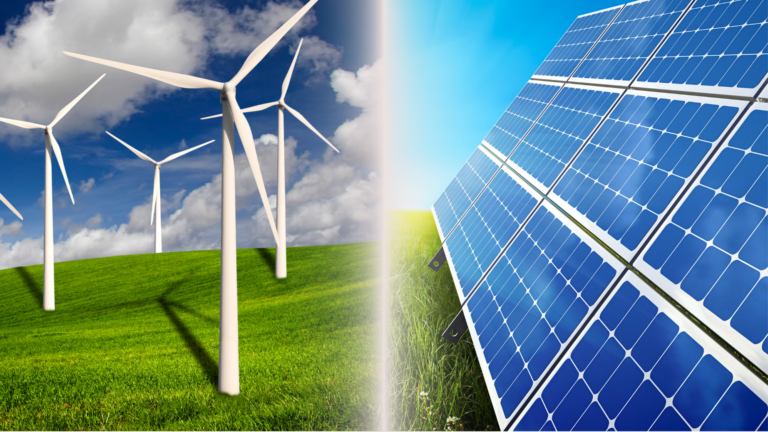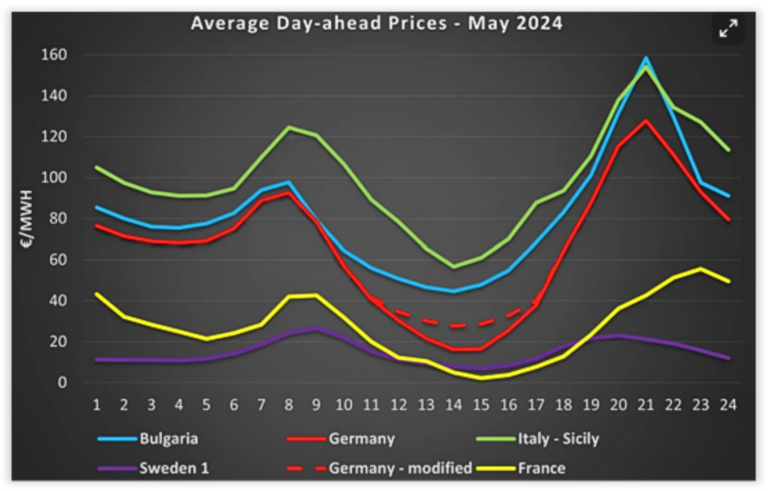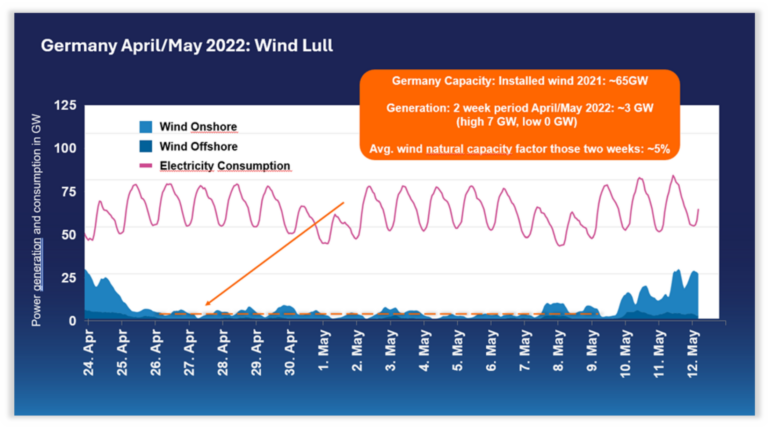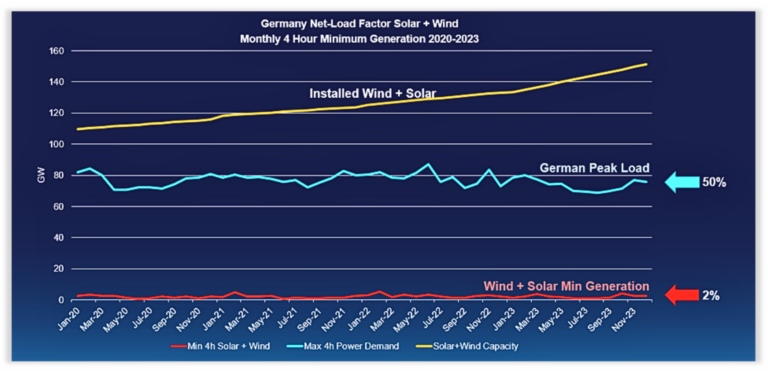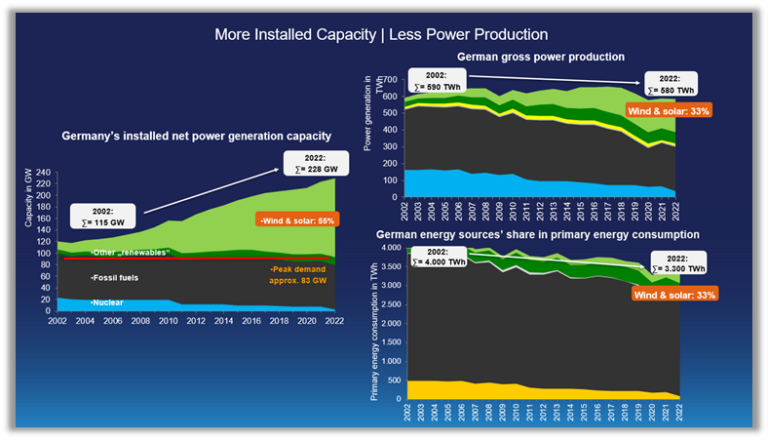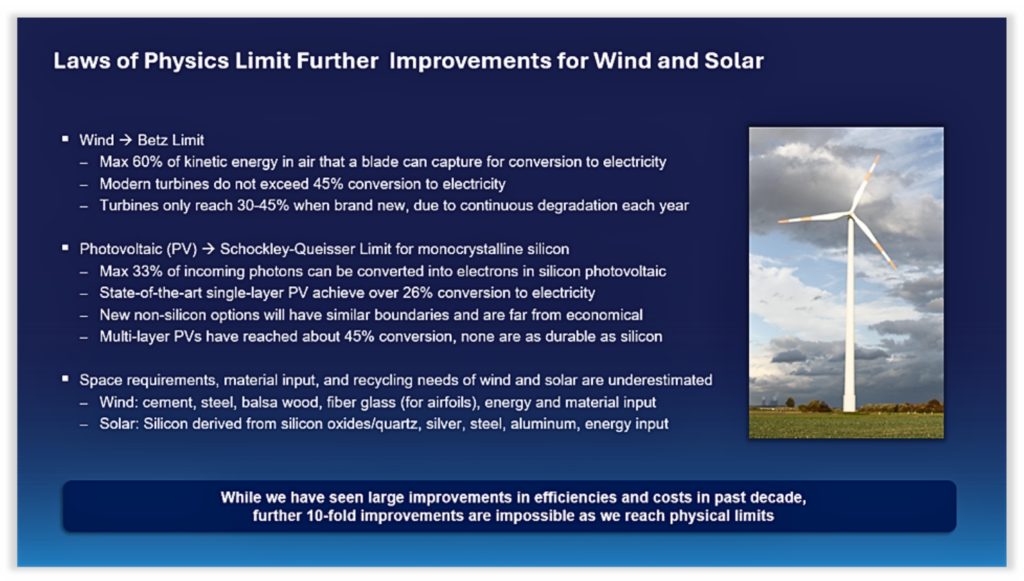When it comes to electricity generation, terms like capacity factor, utilization, and load factor often get thrown around like confetti at a parade. And guess what? They’re not synonymous with one another. There is a lot of confusion about using the term “capacity factor” in the press, certainly in politics, and even amongst “energy experts”.
It’s understandable, though. Knowing what phrases like “natural capacity factor” (nCF), “utilization”, “load factor”, and “conversion efficiency” really mean and which can be influenced/improved with further investment is, in my opinion a crucial piece of the “renewable energy” puzzle…now as always with a puzzle let´s start with some cornerstones/pieces
But first a few words on my motivation and also my bias.
- Why do I care…
Energy is all-encompassing, the basis of everything around us. As obvious and simple as it may be, it took me decades to truly internalize this. I grew up with energy and raw materials, from the day I opened my eyes, but started working with raw materials and energy only 20 years ago when I became a commodity trader. During that time, I spent a large portion of my professional career in the global coal markets but also in the wind energy industry. Professionally I also started to deal with cement and ore products such as iron ore, lithium ore, copper ore, chrome ore, and much more. I am clearly biased!
I am thus often told that I have no “authority” to talk about wind nor solar. Or that my “conventional energy” background as a commodity trader, marketing commodities, including coal products makes me “biased”. Maybe it is time to clarify those two points and why I study wind and solar with so much attention and passion.
As for my authority, I am an energy economist with a couple of decades of experience in commodity and energy markets and strategy consulting. I was also the managing director of a small wind park in Germany for 3 years. Electricity systems are complex, and I am still learning.
The emergence of grid-scale wind and solar, while developed and implemented largely with good intentions, is literally a revolution for electricity markets that I have learnt has undesired consequences. Those consequences I have studied for the past 10 years and I continue to meet policy makers, educators, consumers and producers around the world in relation to the electricity market. My “authority” does not stem from my education, upbringing, nor any title or publication, but it stems from my deep curiosity and complete financial and organizational independence in this regard. That coupled with an almost obsessive interest in critical thinking and optimization has led me to where I am today.
Addressing my bias and my motivations. I speak out FOR dispatchable (conventional) energy systems because of their low cost and their reliability. While I support selected off-grid wind and solar projects, I speak out AGAINST grid-scale intermittent wind and solar systems because of their high-system cost, unreliability, and resulting economic and environmental detriment. I learnt in my years of study that large grid-scale wind and solar systems increase energy shortages and costs. Power prices therefore will increase and price volatility with it (Figure 1).
I would like for you to consider that the fossil fuel industry will thrive when energy shortages prevail. Because energy-starved times will always be accompanied by high and volatile raw material and electricity prices, leading to extra profits for anyone producing or even trading energy raw materials and generating electricity. This can be seen in the record profits earned by large oil, gas, and coal companies during the last 3 years.
Thus, if anything, I am negatively incentivized to write about how the world can avoid energy shortages. I should, from a personal economic point of view, remain silent. However, my motivation is to educate and explore what is right for the world and what we can do to optimize our energy production. I wholeheartedly support to further reduce the environmental impact of our energy system.
As for the future, it becomes apparent that INvestment in, not DIvestment from, conventional forms of energy is the only viable environmental and economic pathway until we undergo a so-called New Energy Revolution. The New Energy Revolution is a point in time when humanity may sustainably wean itself off fossil fuels. Such a new energy system may be completely original, possibly a combination of fusion or fission, solar, tidal, geothermal, or a presently unknown energy source. It would likely harness the power of the nuclear force, the power of our planetary system (i.e., sun, gravity), and the energy from within our planet. It will have little to do with today’s wind and photovoltaic technologies due to the physical limitations of energy density, or energy available per m2, and – most importantly – their intermittency.
Leading up to this New Energy Revolution we need to install and utilize the latest available technologies, not only but especially for coal, which is available at a relatively low cost.
We must do everything in our power to increase net energy efficiencies (eROI) in the production of electricity and, entirely independently and very distinctly, further increase energy efficiencies in the utilization of electricity.
Therefore, I urge energy policy makers to refocus on energy policy’s three objectives in that order: (1) energy security, (2) energy affordability, and (3) environmental protection. This translates into two paths for the future of energy:
- (ONE) Invest in education and basic research to pave the way toward a New Energy Revolution in which energy systems can sustainably be weaned off fossil fuels, but at an increase in energy availability per capita.
- (TWO) In parallel, energy policy must support investment in conventional energy systems to improve their efficiencies and reduce the environmental burden of energy generation for our lives, at least until the New Energy Revolution has been realized. This includes, for power – in order of importance: coal, gas, nuclear, hydro, waste, geothermal.
Now back to the determining matter of capacity factor.
Figure 1: European power price volatility
Note: Average market prices for 5 countries. For Germany, a modified curve is presented where negative prices have been set to 0 instead, to highlight the impact of large negative prices on the average prices.
Source: Julian Jumaux substack, June 2024, based on publicly available information
2. Natural capacity factor (nCF), utilization, load factor, and conversion efficiency… what does it all mean?
The “natural capacity factor (nCF)” is the percentage of the maximum possible output of the “power plant” (coal, gas, nuclear, solar, wind, hydro, etc), achieved under the natural conditions of the site, assuming no operational or technological failures or outages.
To avoid confusion, I try to use “natural capacity factor” instead of the shorter “capacity factor” in my writing wherever possible.
I define “utilization” as the percentage of the power plant’s workable capacity used on average throughout the year, which is only reduced by technological, operational, economical outages, or curtailments… completely independent of the nCF.
The “net load factor” – in my definition – is the product of the natural capacity factor and utilization.
- natural capacity factor (nCF) x utilization = net load factor
Thus, when we speak of the natural capacity factor, we are only referring to the capacity factor derived from nature, not the technological or operationally driven “utilization” (often referred to as uptime, plant load factor, or PLF).
In other words, when technology fails, or a power plant is turned off on purpose, this will reduce the utilization but not the natural capacity factor.
None of these terms have anything to do with conversion efficiency, which measures the ratio between the useful output of an energy conversion machine (or factory or plant) and the input, in energy terms. For example, the % of dispatchable electricity a gas-fired power stations “produces” from inflowing gas, or the % of intermittent electricity a solar panel “produces” from the incoming sunshine. Both gas and sunshine are primary energy, for more details please refer to my recent blog post.
Now that we have a better understanding of the terminology let’s continue…
Figure 2: Global average capacity factors according to Carbajales-Dale et al. 2014
Source accessed 11 Feb 2022 : Global Wind Atlas (setting Mean Power Density – for the 10% windiest in the selection region at 100m height), www.globalwindatlas.info; Global Solar Atlas, www.globalsolaratlas.info (setting Direct normal irradiance, DNI)
3. The facts and figures
The worldwide average of solar’s natural capacity factor (nCF) ranges between ~11-13%. Even in the best locations in the world, namely California, Australia, South Africa and the Sahara it could exceed 25%, but this is rare. (Link in section below)
When looking at the worldwide average of wind’s natural capacity factors (nCF) it reaches around ~21-24% with the best offshore locations, situated in Northern Europe, seldom reaching levels above 40%. Most of Asia and Africa hardly have any usable wind and the average nCF lies below 15%, except for particular areas on the coasts of South Africa and Vietnam. (Link in section below)
The natural capacity factors in Europe tend to be higher for wind than for solar. Although wind installations in Northern Europe could reach an average of over 30% (which is higher for more expensive offshore wind farms and lower for onshore), this average sinks drastically to less than 15% in India and less than 8% in Indonesia.
The average, with emphasis on average, is annual solar PV capacity factors reaching around ~10-11% in Germany, ~17% in Spain, ~25% in California, and may reach 14-19% in India, but still falls short of 15% in Indonesia’s populated areas.
Figure 2 below illustrates a two week period in May 2022 (when I wrote the chapter of our book “The Unpopular Truth… about Electricity and the Future of Energy” on capacity factors), where the average wind capacity factor reached only ~5% for ALL of Germany’s wind installations (on- and offshore).
Figure 3: Germany April/May 2022: Wind Lull
Source: April May 2022 Data, Agora: https://www.agora-energiewende.de/en/service/recent-electricity-data/chart/power_generation/24.04.2022/12.05.2022/today/
4. “Natural capacity factor” and utilization explained
As mentioned, the “natural capacity factor” results from the site of the solar PV installation, and not from the installation itself. Thus, even state-of-the-art PV installations still face the limitations of the natural capacity factors with an annual average of 10-25%, not taking other losses from conditioning, transmission, balancing, nor storing highly intermittent sources of electricity into account. (Schernikau and Smith 2021).
When I see mentioned in the press that on average coal or gas have “capacity factors” of 60% or less and comparing this to a 30% “capacity factor” of wind, I cannot help but question the political motivation behind this misleading or rather outright incorrect statement.
Such a “capacity factor” number for coal or gas is not their natural capacity factor, but rather illustrates their low utilization which declines even more with the increasing adoption of wind and solar and contributes to electricity system cost increases. This low utilization contributes to the low average net load factor of a coal or gas plant which may then equal only 60% or less.
As you now see, utilization should not and can never be compared to the “natural capacity factors”, they are two very different elements of measure.
Conventional power plants have near 100% natural capacity factors, but their operational and technological utilization often falls significantly below 90%, often but not only due to the priority given to wind and solar in the system.
The other reason is simply the response to demand fluctuations, that dispatchable coal and gas can comply with. For a conventional power plant, the net-load factor is only slightly lower than utilization, because of their high natural capacity factor.
Contrary to conventional power, the utilization of wind and solar often lies near 100%, with their net-load factor only slightly lower than their natural capacity factor. The high utilization is also but not only driven by grid priority given for intermittent wind and solar in most grid systems and of course the near zero marginal cost.
- natural capacity factor (nCF) x utilization = net load factor
As discussed in this recent article, the low MARGINAL cost of wind and solar does not translate to low TOTAL system cost, which is relevant for a country.
Figure 4: Wind + Solar net load factor for first monthly 4h period in Germany 2000-2024
Source: Lars Schernikau, based on Agora
5. Location is everything… but also limited
Needless to say, the “natural capacity factor” of wind and solar (including hydro due to natural river flows illustrated by high hydro variability in countries such as Vietnam or India) cannot be accurately predicted nor guaranteed for any given time frame. The “natural capacity factor” can only be estimated on an annual basis but even then, still varies widely (see Europe in 2021 and 2022) due to its very erratic nature. We have seen wind and solar, even in top locations, reaching near 0% for days and weeks on end (Figures 2 and 3).
Thus, “natural capacity factors” worldwide are a direct result of the location of the wind or solar installation; they do not in any way depend on and cannot be influenced by the technology employed.
The very important point I would like to make here is that… no technological advances can change/improve the natural availability of wind, solar, or river flows and therefore influence the natural capacity factor of any given installation. Technology CAN and WILL improve how much usable electricity you extract from the natural input product (wind, solar, river flow, gas, coal, uranium, etc) which is referred to as conversion efficiency and the limits thereof we will be discussed further below.
Since we have already occupied the prime locations for wind and solar installations, one could logically expect the average “natural capacity factors” to decline over time contradicting Net-Zero plans that often assume average global natural capacity factors will increase (see IEA, McKinsey, BCG, IRENA, and many more)
- For a photovoltaic (PV) park, the natural capacity factor nCF depends entirely on the intensity and duration of the sunlight, which is affected by seasonality and cloud cover, day and night, and the maintenance of the PV panel’s surface transparency, e.g., dust in the Sahara or snow in winter.
- Wind farms’ natural capacity factors depend on the site’s wind speed distribution and the saturation speed of the wind turbine. The nCF of a wind turbine is determined by the number of hours per year in which the wind farm operates at or above the saturation wind speed (Smith and Schernikau 2022). If the wind saturation speed is set low, e.g., 4-5 m/s, the wind farm produces little energy, even when the capacity factors are high. Typically, wind saturation speeds are 12-15 m/s.
It now becomes apparent why the installed capacity for wind and solar needs to be much larger than for dispatchable power such as nuclear, coal, gas, or hydro. This significant increase in energy generation capacity to produce the same available, but unpredictable, energy output is coupled with a significantly higher raw material and energy input factor for variable “renewable” energy which must be offset from any, so called, fuel savings.
Figure 4 illustrates a good example: in Germany, the total installed power capacity more than doubled in the past 20 years, essentially all resulting from wind and solar. The wind and solar installed capacity is now over 150 GW, which is alone double the peak power demand in Germany of around 80GW. Germany’s conventional installed power capacity, consisting of coal, gas, previously nuclear, hydro, and biomass still barely matches peak power demand. So, even with all this additional capacity in Germany, wind and solar made up a bit more than 30% of total electricity generation in 2022 and about 6% of total energy consumption.
Without any doubt, the low natural capacity factor of wind and solar installations, is partly driven by their low net-energy efficiency.
(Link in section below – Source Schernikau et al 2022: Full Cost of Electricity ‘FCOE’ and Energy Returns ‘eROI.’ Journal of Management and Sustainability 12, no. 1 (May 2022): p96)
Figure 5: German installed power capacity, power generation, primary energy.
Sources: Schernikau based on Fraunhofer, Agora, AG Energiebilanzen. See also www.unpopular-truth.com/graphs.
6. Conversion Efficiency
So, what is conversion energy? Conversion efficiency measures the ratio between the useful output of an energy conversion machine and the primary energy input, in energy terms, completely independent of the natural capacity factor or utilization of such a plant or equipment. Read more on Why Primary Energy is Still King.
In Figure 5 you will find a summary of the energy conversion efficiencies for wind and solar and the laws they follow. The conversion efficiency of a solar or gas-fired power station basically measuring how much useful electricity the plant can “extract” from the the primary energy contained in the sun or gas it is “fed with”.
It is correct that the primary energy fuel “sun”, is renewable, compared to the primary energy fuel “gas”, which is not renewable. But the installations required to convert this primary fuel (renewable or not) is never “renewable”. Most importantly, energy density and intermittency dictates the size and complexity of such “primary energy collection and conversion equipment”. For more details see here.
7. In Summary
Understanding the intricacies of terms like natural capacity factor, utilization, load factor, and conversion efficiency is essential in the realm of energy and electricity generation, especially with the increasing integration of wind and solar based energy sources. The confusion, often perpetuated by the media and politicians, highlights the need for clarity even more.
It’s crucial to distinguish between the natural capacity factor (nCF), which is determined by the natural conditions at the power plant’s location, and utilization, which reflects the operational use throughout the year. These distinctions are key pieces of the “renewable” energy puzzle, helping us appreciate the challenges and limitations inherent in harnessing energy from variable sources like wind and solar in comparions to conventional dispatchable power systems.
In essence, while technological advancements can enhance how efficiently we convert natural primary energy resources such as wind, solar, coal, gas, uranium, water flows, and more into usable electricity, it cannot change the fundamental availability of these resources.
The variability of wind and solar energy, influenced by location and natural conditions, highlights the necessity for larger installed capacities compared to more predictable power sources such as coal, gas, or nuclear. As we continue to develop our energy systems, recognizing these differences will be vital in shaping realistic and effective renewable energy strategies for the future.
I hope we all now better understand nature’s influence on solar and wind power generation.
None of what I write precludes us or excuses us from doing all in our power to further improve the environmental and economic efficiency of our existing energy systems.
Links and Resources
- Global Solar Atlas
- Global Wind Atlas
- Noland et al 2022: Spatial Energy Density of Large-Scale Electricity Generation from Power Sources Worldwide. Scientific Reports 12, no. 1 (December 2022): 21280. https://doi.org/10.1038/s41598-022-25341-9.
- Carbajales et al 2014: Can We Afford Storage? A Dynamic Net Energy Analysis of Renewable Electricity Generation Supported by Energy Storage. Energy & Environmental Science 7, no. 5 (April 2014): 1538–44. https://doi.org/10.1039/C3EE42125B.
Schernikau et al 2022: Full Cost of Electricity ‘FCOE’ and Energy Returns ‘eROI.’ Journal of Management and Sustainability 12, no. 1 (May 2022): p96. https://doi.org/10.2139/ssrn.4000800.

